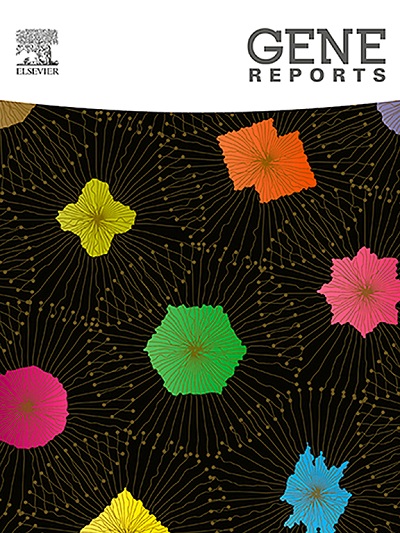Whole exome sequencing in 33 patients revealed 4 novel variants in 11 limbs-girdle muscular dystrophy families
IF 1
Q4 GENETICS & HEREDITY
引用次数: 0
Abstract
Introduction
Muscular dystrophies (MD) are a large heterogeneous group of over 60 neuromuscular disorders caused by mutations in nearly 60 different genes. These conditions lead to varying degrees of neuromuscular dysfunctions, leading to muscular dystrophies-atrophies, gait abnormalities or waddling, tip-toe walking, difficulties in climbing stairs, dilated cardiomyopathy, and respiratory distresses.
Methods
In this study, we for the first time examined 67 individuals from 11 families, of whom 33 were affected ranging from 4 to 30 years. Whole exome sequencing was conducted on an index patient from each family, and the causative variants were identified using our in-house data analysis pipeline. The candidate variants were further validated through Sanger sequencing in the family to confirm the segregation of the affected alleles.
Results
Patients primarily showed progressive weakening of muscles, changes in muscle tone or structure and the development of an abnormal gait, eventually leading to loss of ambulation. The severity of the disease varied both within and between families. This study identified four novel pathogenic variants (COL6A1; c.1659_1665dup; p.Pro555_Asp557dup, DMD; 145.7Kb cytogenetic band Xp21.1 deletion, DMD: 40.3Kb cytogenetic band Xp21.1 duplication and HMGCR; c.1537C > T; p.Pro513Ser) and six recurrent variants (DMD; c.1032 T > A; p.Tyr344Ter, DMD; c.3923C > A; p.Ser1308Ter, CAPN3; c.379 + 3 A > G, DYSF; c.4251del; p.Ile1418SerfsTer47, ANO5; c.692G > T; p.Gly231Val. and LAMA2; c.1300C > T; p.Arg434Ter) in seven MDs associated genes (COL6A1, DMD, CAPN3, DYSF, HMGCR, ANO5, and LAMA2).
Discussion
In this study, we identified four novel and six recurrent pathogenic variants in seven genes, expanding the genetic basis of MD and providing a valuable resource for further diagnostic and therapeutic approaches. These findings have significant implications for enhancing the understanding of MD pathogenesis and may guide the development of personalized therapeutic strategies for affected individuals. Overall, this study contributes to advancing the genetic diagnostics of MD and offers new avenues for therapeutic interventions, potentially improving patient outcomes.
33例患者的全外显子组测序在11个四肢-带状肌萎缩症家族中发现了4个新的变异
肌营养不良症(MD)是由近60种不同基因突变引起的60多种神经肌肉疾病的一大异质性群体。这些情况导致不同程度的神经肌肉功能障碍,导致肌肉营养不良-萎缩,步态异常或摇摇晃晃,踮脚走路,爬楼梯困难,扩张性心肌病和呼吸窘迫。方法首次对来自11个家庭的67名患者进行调查,其中33名患者年龄在4 ~ 30岁之间。对每个家庭的索引患者进行全外显子组测序,并使用我们内部的数据分析管道确定致病变异。候选变异通过Sanger测序在家族中进一步验证,以确认受影响等位基因的分离。结果患者主要表现为肌肉进行性衰弱,肌肉张力或结构改变,步态异常,最终导致行动能力丧失。这种疾病的严重程度在家庭内部和家庭之间都有所不同。该研究鉴定出四种新的致病变异(COL6A1;c.1659_1665dup;p.Pro555_Asp557dup模式;145.7Kb细胞遗传带Xp21.1缺失,DMD: 40.3Kb细胞遗传带Xp21.1重复和HMGCR;c.1537C祝辞T;p.Pro513Ser)和6个复发变异体(DMD;c.1032T比;一个;p.Tyr344Ter模式;c.3923C祝辞一个;p.Ser1308Ter CAPN3;c.379 + 3 A >;G, DYSF;c.4251del;p.Ile1418SerfsTer47 ANO5;c.692G祝辞T;p.Gly231Val。和LAMA2;c.1300C祝辞T;p.Arg434Ter)在7个MDs相关基因(COL6A1、DMD、CAPN3、DYSF、HMGCR、ANO5和LAMA2)中的表达。在这项研究中,我们在7个基因中发现了4个新的和6个复发的致病变异,扩大了MD的遗传基础,并为进一步的诊断和治疗方法提供了宝贵的资源。这些发现对增进对MD发病机制的理解具有重要意义,并可能指导患者个性化治疗策略的发展。总的来说,这项研究有助于推进MD的遗传诊断,并为治疗干预提供新的途径,潜在地改善患者的预后。
本文章由计算机程序翻译,如有差异,请以英文原文为准。
求助全文
约1分钟内获得全文
求助全文
来源期刊

Gene Reports
Biochemistry, Genetics and Molecular Biology-Genetics
CiteScore
3.30
自引率
7.70%
发文量
246
审稿时长
49 days
期刊介绍:
Gene Reports publishes papers that focus on the regulation, expression, function and evolution of genes in all biological contexts, including all prokaryotic and eukaryotic organisms, as well as viruses. Gene Reports strives to be a very diverse journal and topics in all fields will be considered for publication. Although not limited to the following, some general topics include: DNA Organization, Replication & Evolution -Focus on genomic DNA (chromosomal organization, comparative genomics, DNA replication, DNA repair, mobile DNA, mitochondrial DNA, chloroplast DNA). Expression & Function - Focus on functional RNAs (microRNAs, tRNAs, rRNAs, mRNA splicing, alternative polyadenylation) Regulation - Focus on processes that mediate gene-read out (epigenetics, chromatin, histone code, transcription, translation, protein degradation). Cell Signaling - Focus on mechanisms that control information flow into the nucleus to control gene expression (kinase and phosphatase pathways controlled by extra-cellular ligands, Wnt, Notch, TGFbeta/BMPs, FGFs, IGFs etc.) Profiling of gene expression and genetic variation - Focus on high throughput approaches (e.g., DeepSeq, ChIP-Seq, Affymetrix microarrays, proteomics) that define gene regulatory circuitry, molecular pathways and protein/protein networks. Genetics - Focus on development in model organisms (e.g., mouse, frog, fruit fly, worm), human genetic variation, population genetics, as well as agricultural and veterinary genetics. Molecular Pathology & Regenerative Medicine - Focus on the deregulation of molecular processes in human diseases and mechanisms supporting regeneration of tissues through pluripotent or multipotent stem cells.
 求助内容:
求助内容: 应助结果提醒方式:
应助结果提醒方式:


